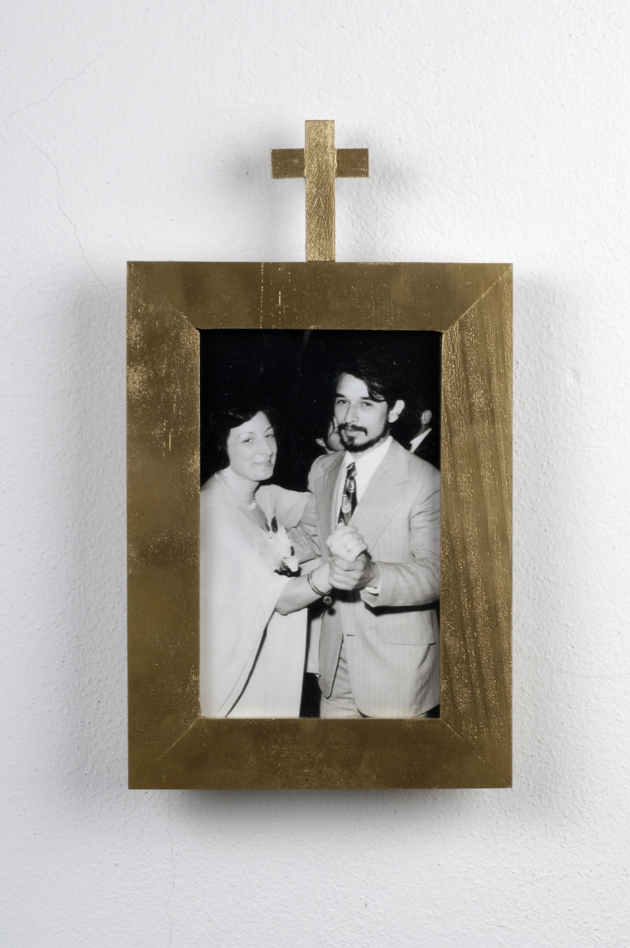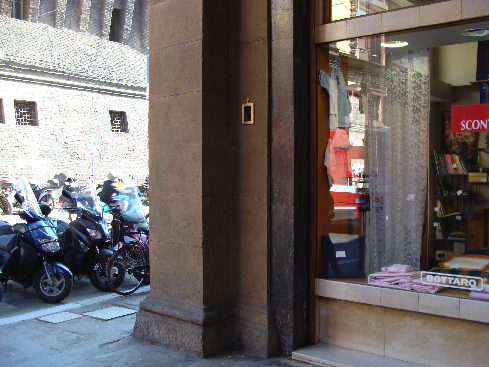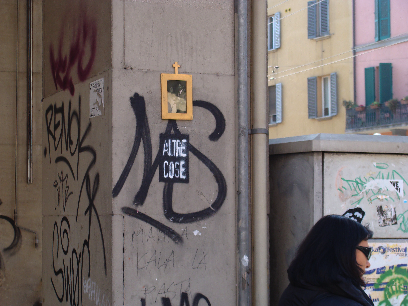senza titolo n. 46
14 digital photos on wood frames
2012
EN
The series of work draws is inspired from the private life of the artist and is an introspective investigation of his relationship with his biological father whom, at the moment of birth was not recognized its paternity. The main pivot around which the series is based on is the figure of Ugo Bassi, patriot of the city of Bologna which dedicated him one of its most fashionable street and whom bears the same surname of the artist father figure.
The homonyms becomes the artist inspiration to investigate on his denied identity, that theme is cathartically merged with those of suffering and death, recalled from the use, whether explicit or indirect, of funerary objects or references to the Christian ritual.
The strong physical resemblance to the artist with the father figure, accentuated further by the use of photographs of his father at a young age, the reference to a fallen, the obsessive fascination with the name Netherlands, are all elements that the artist interact with and short-circuit around with each other, in a continuous game of mirrors. From the formal point of view the use of photographic portraits as a means of telling the truth is part of the collective memory that lies in the imagination of Argentine society, the home of the artist, from photographs used by the Madres de Plaza de Mayo from them used in an attempt to trace back the existence of missing persons such as “disappeared” relatives. The photograph itself will always refer to the idea of death because, as Roland Barthes stated, when a picture is taken, the instant chose to be fixed has already passed. In his book Camera Lucida, the literary critic and essayist French explains, “Photography does not say (of course), what is no longer but says only and certainly what it was. This subtlety is crucial. “The photographic image acts as a kind of abstraction of life as well as death and therefore has absence of representation. This series of works by Contreras is pervaded by the theme of death, memory and loss and closure, his debt to the poetry of Christian Boltanski, who, through the use of photography, performs destructive memory, capable to witness the passage of time. Entering the specific work of Sebastián Contreras, the work “Untitled n. 44 “ it consists of a photograph of the artist’s father at a young age framed and glued on the outside of the porch of one of the main streets of the city center of Bologna, Via Ugo Bassi. A few meters away is the monument dedicated to the patriot of the Italian Risorgimento figure Ugo Bassi precisely of whom its name was given to the street. The photograph is placed at a specific point of the wall in order to follow the gesture of the statue, which seems to indicate it with the hand. The fourteen squares work “Untitled n. 46 “ positioned along the same street Ugo Bassi represents the way of the cross. The fourteen stations of the metaphorical ordeal show the same picture of the artist’s father (portrayed in a dance with the mother-in-law, at the wedding of his sister) goes progressively darker to become the last of these, completely black.
These two works were designed as site-specific installations, and set up in the urban context of the city. The main focused figure of the patriot Bolognese artist in the work “Untitled n. 48 “ which approaches a willingness to re-appropriation of identity remotely by the cast of the name Ugo Bassi. Note the technical aspect and the research of materials used by Sebastian Contreras for the creation of his works. In this case the fragility of tissue paper engraved translates metaphorically into spirituality, inconsistency and immateriality. The operation was performed by the technique of frottage directly taken on the letters carved nell’epitaffio tomb of the Patriot, located in the cemetery of the Certosa of the city of Bologna.
Despite the fact that the artist’s father, whom is depicted in the work “Untitled n. 55 “, is still alive, the oedipal desire of classic Freudinism. The death of his father led the artist to realize the tomb.
The work shows a complex nature in relation to the deepening of the greek myths: according to myth, in fact, Oedipus did not know his real parents, having been abducted when still infant. Similarly, the artist met his father only in his adulthood. Also in this case it assumes particular importance the particularity of the materials used. A real marble plaque made by a craftsman creates an estrangement contrast due to a total lack of written and dates to the plate itself. In this way it is further highlighted the photographic image at the center of the work, this was also made with the technique of photoceramic used in cemeteries, so as to withstand time and weathering. As in other cases, the remarkable similarity of physiognomy between father and son is part of the game of otherness/identity based on the use of photographs of the artist’s father at a young age, the game that turns into an attempt to undo the temporal distances between subjects, which is no longer accessible.
IT
La serie di lavori trae ispirazione dalla vita privata dell’artista e si pone come indagine introspettiva sul suo rapporto con il padre biologico che, al momento della nascita, non ne riconobbe la paternità. Principale perno attorno al quale ruota la serie è la figura di Ugo Bassi, patriota bolognese al quale è dedicata una nota via della città, in quanto portatore dello stesso cognome della figura paterna. L’omonimia diventa per l’artista spunto di indagine sulla propria identità negata, tema che viene catarticamente fuso con quelli della sofferenza e della morte, richiamati dall’utilizzo, sia esplicito che indiretto, di oggetti funerari o di rimandi alla ritualità cristiana. La forte somiglianza fisica dell’artista con la figura paterna, accentuata ulteriormente dall’utilizzo di fotografie del padre in età giovanile, il riferimento ad un caduto, l’ossessiva fascinazione per il nome Bassi, sono tutti elementi che l’artista fa interagire e cortocircuitare tra loro, in un continuo gioco di specchi. Dal punto di vista formale l’utilizzo dei ritratti fotografici come mezzo per raccontare la verità fa parte della memoria collettiva che soggiace nell’immaginario della società argentina, terra
d’origine dell’artista, a partire dalle fotografie utilizzate dalle Madres di Plaza de Mayo da loro usate nel tentativo di (rin)tracciare l’esistenza delle persone scomparse, i parenti “desaparecidos”. La fotografia in sé rinvia sempre all’idea della morte poiché, come affermava Roland Barthes, nel momento in cui si scatta una fotografia, l’instante scelto da fissare è già passato. Nel suo libro La camera chiara, il critico letterario e saggista francese spiega: “La Fotografia non dice (per forza), ciò che non è più ma soltanto e sicuramente ciò che è stato. Questa sottigliezza è determinante.” L’immagine fotografica si comporta come una sorta di astrazione della vita così come la morte e dunque è rappresentazione dell’assenza. Questa serie di lavori di Contreras è pervasa dal tema della morte, della memoria e della perdita e appalesa, il suo debito verso la poetica di Christian Boltanski il quale, tramite l’utilizzo della fotografia, compie un’azione destrutturante della memoria, in grado di testimoniare lo scorrere del tempo. Entrando nello specifico del lavoro di Sebastián Contreras, l’opera “Senza titolo n. 44” è composta di una fotografia del padre dell’artista in età giovane incorniciata e incollata sul lato esterno del portico di una delle vie principali del centro di Bologna, via Ugo Bassi. A pochi metri si trova il monumento dedicato al patriota del Risorgimento italiano, Ugo Bassi appunto, il quale dà il nome alla via. La fotografia è posizionata in un punto specifico della parete, a seguire il gesto della statua, che pare indicarla con la mano. I quattordici quadretti dell’opera “Senza titolo n. 46” posizionati lungo la stessa via Ugo Bassi rappresentano una via crucis. Le quattordici stazioni del metaforico calvario mostrano la stessa fotografia del padre dell’artista (raffigurato in un ballo con la suocera, alle nozze della cognata) che va progressivamente inscurendo fino a diventare, nell’ultima di queste, completamente nera. Queste due opere sono state concepite come installazioni site specific, e allestite nel contesto urbano della città. Sempre incentrata la figura del patriota bolognese l’artista nell’opera “Senza titolo n. 48” si approccia a una volontà di riappropriazione dell’identità remota attraverso il calco del nome Ugo Bassi. E’ da notare l’aspetto tecnico e la ricerca nei materiali utilizzati da parte di Sebastiàn Contreras per la creazione delle sue opere. In questo caso la fragilità della carta velina incisa si traduce metaforicamente in spiritualità, inconsistenza e immaterialità. L’operazione è stata effettuata mediante la tecnica del frottage direttamente sulle lettere scolpite nell’epitaffio della tomba del patriota, situata nel cimitero della Certosa di Bologna. Nonostante il padre dell’artista, raffigurato nel lavoro “Senza titolo n. 55”, sia ancora in vita, il desiderio edipico, di concezione classica freudiana, della morte del padre, porta l’artista a realizzarne il sepolcro. L’opera mostra una natura complessa anche in relazione all’approfondimento del mito greco: secondo il mito, infatti, Edipo non conosceva i suoi veri genitori, essendo stato a questi sottratto ancora infante. Allo stesso modo l’artista ha conosciuto suo padre solo in età adulta. Anche in questo caso assume particolare rilevanza la particolarità dei materiali utilizzati. Una vera lapide in marmo fatta realizzare da un artigiano contrasta con lo straniamento dovuto alla totale mancanza di scritte e date sulla lastra. In questo modo viene ulteriormente evidenziata l’immagine fotografica posta al centro dell’opera, anche questa realizzata con la tecnica della fotoceramica impiegata nei cimiteri, così da resistere al tempo e alle intemperie. Come negli altri casi, la notevole somiglianza fisionomica fra padre e figlio rientra nel gioco di alterità/identità basato sull’utilizzo delle fotografie in giovane età del padre dell’artista, gioco che si converte in un tentativo di annullare le distanze temporali fra i soggetti, ormai non più raggiungibili.





